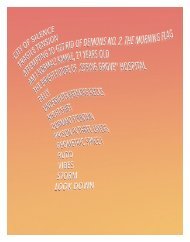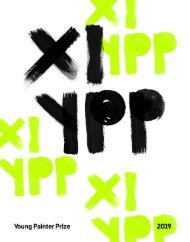X YPP Book
The main aim of the project - to discover new talent in Baltic States.
The main aim of the project - to discover new talent in Baltic States.
Create successful ePaper yourself
Turn your PDF publications into a flip-book with our unique Google optimized e-Paper software.
Interview 120<br />
• Why painting? (How did you discover this medium and why have you chosen it?)<br />
I always loved drawing and painting. I went to several art schools, which I really<br />
enjoyed. I was also interested in theatre, scenography, and fashion design.<br />
People kept saying that it was very difficult to get into Vilnius Academy of Arts,<br />
but I braved myself and got in. It was a rather spontaneous decision. I now feel<br />
that I am in the right place. Painting has always been giving me a chance to<br />
understand and realise myself better, and to observe and analyse the world<br />
more deeply.<br />
• What inspires you? (Individuals, contexts, etc.)<br />
I use tracks, scores, and rows to signify alienation, normativity, and loneliness.<br />
Finding interesting sports-related stencils or numbers always inspires me to<br />
think of the new motifs and and ideas. I also find the soviet legacy to be<br />
important for my art. The sight of certain walls, wallpapers and sports inventory<br />
can bring back memories and evoke a strange nostalgia. I am emotionally<br />
attached to all these steamy sports halls with their green walls and brown<br />
benches, with those weird yellows and mouldered blues — all those colours and<br />
their combinations bring back repressed memories and feelings that serve as an<br />
inspiration.<br />
• Creative motifs. (What drives your creative practice? What are the topics you are<br />
working on?)<br />
In my works I am touching upon the topics of the disappearance of authenticity<br />
and personality, and the complexity of seeing oneself as an individual. My<br />
painting is about the freedom of being different. Many of my motifs are based on<br />
the imagery of the sports lessons because of my personal experiences and the<br />
desire to liberate myself from them. All these creative ideas are somehow<br />
related to the memories of me jumping over the trestle, making rollovers, or<br />
hanging on a crossbar. A sports hall full of all kinds of children — tall, short,<br />
stocky, spectacled, weak and energetic — and everyone has been attempting at<br />
doing the same tasks. Hanging, climbing, falling down, hanging again, and<br />
jumping up. These distant spaces and exercises are still vivid in my memory. I<br />
feel haunted by them. And my yet unrealised creative tasks are a reminder that<br />
life itself need me to perform and comply with norms.<br />
• What can you tell us about your creative process? Where does your artwork start<br />
and where does it end?<br />
As I look back at these dirty and wind-swept stadiums, I find myself revisiting the<br />
situations when both possibilities and individual choices were still far from my<br />
aspirations. I revitalise those scenes through painting. I thus travel back to those<br />
halls lit by the fluorescent lamps. I am trying to find a relation to the past and the<br />
social environment in which every deviation from the norm resulted in of social<br />
ostracism of one kind or another.<br />
I find the landscape structure that dominates in my pantings important to me:<br />
I regard my past as a series of well trodden and ever-changing landscapes that<br />
sometimes can be completely fictional. The sketchiness in my works refers to<br />
a fleeting nature of a memory. I approach painting differently each time I am<br />
in front of the canvas. The paintings can never be completely finished, and the<br />
empty spaces in them are the clues to the aesthetic continuity between them.<br />
• Have you ever seriously doubted your choice to become an artist? (If so, what<br />
stopped/reassured you?)<br />
I don’t think I have. I like the path I have chosen.<br />
• Do you find the Baltic art scene interesting? (What is your opinion about<br />
Lithuanian, Latvian and Estonian art? How would you describe their differences?)<br />
The art of the Baltic region always interested me with its variety of different<br />
stories and motifs, which is always evident in various collaborative projects and<br />
group exhibitions. I find a lot of sensitivity and depth in the works by the Baltic<br />
region artists. I always enjoy visiting the shows, art fairs and performances where<br />
I can encounter their explorations of narrativity, time, memory, everyday truths<br />
and paradoxes of life.<br />
• How did the Young Painter Award influence your artist’s career?<br />
Actually, this Award was really unexpected for me. Being recognised was very<br />
pleasing, I became more confident. These things are important for young artists.<br />
The Award did in fact open the doors to new exhibitions and helped with my<br />
visibility, not to mention the memorable residence in Norwegian mountains<br />
where I had a chance to develop many creative ideas.





